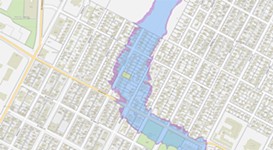K2 Rampages Red River
What can the city do to stop the "walking dead"?
By Nina Hernandez, Fri., April 7, 2017

Austin's K2 epidemic isn't getting better.
For three years, the Austin Police Department, Austin Fire, and Emergency Medical Services have collectively grappled with this poisonous drug, which is smoked like marijuana, but can spark violent seizures or render its users comatose from as little as one hit. Problems seem to show up en masse: Last Thanksgiving, nearly 50 people were hospitalized for bad reactions; a spokesperson for ATCEMS said January was the fourth highest month for K2 calls in the past five years; and on March 30, medics responded to a mass casualty event that sent 33 people to area hospitals. Those calls continued throughout the weekend. On Tuesday at 6pm, the department tweeted a graphic indicating that, in the previous 18 hours, 36 people had been attended to by medics for suffering K2's negative effects.
Though the issue is citywide, K2 is particularly devastating Downtown, especially around the Austin Resource Center for the Homeless on Seventh Street, where homeless people often gather for easy access to the many services within the area. Predatory dealers sell the drug as a marijuana substitute that provides an intense high for little money. Reactions can be so severe people pass out in the street, in alleyways, and along sidewalks. "The large majority of homeless people have mental illness, and an even larger proportion have a co-occurring substance abuse problem along with mental illness," said APD's Downtown Area Commander Justin Newsom. "They're an easy prey and easy victim for a person that's trying to make a dollar."
And, boy, are manufacturers making a hefty dollar. According to APD, a half-gram "stick" of K2 goes for $5 on the street. But the manufacturer spends only 90 cents to make a 10-gram bag. The inexpensiveness coupled with that wide profit margin means K2 use is not a problem police can simply arrest away, though the department has certainly tried. But dealing with 7 to 10 K2 overdoses each day is stretching Downtown Command, which has a wide swath to police with fewer than a dozen working officers during daytime hours. And that's just a normal day. Mass casualty incidents, like the ones that have taken place over the past week, put an even deeper strain on resources, across agencies.
One avenue to changing the status quo could be community outreach. In a March 6 press conference announcing the arrest of 36 K2 dealers, Organized Crime Commander Troy Officer said it was a disservice to the community to call K2 a "synthetic marijuana. ... This is no more marijuana than if I put bleach in a martini glass and called it a cocktail." Newsom noted that because the drug has been illegal since 2011, there are no safety standards to ensure the marketed product hasn't been sprayed with a chemical that will make users sick. Kay Klotz of Front Steps, the nonprofit that oversees the ARCH, said her staff can tell when there's a bad batch in town: "People are just dropping."
"We all wish we had the answer, but we don't," she continued. "So what we do is just what we always do: We take care of people who are here for services."
On Tuesday, Barracuda partner Jason McNeely posted videos of a recent overdose to Facebook, tagging Mayor Steve Adler and Mayor Pro Tem Kathie Tovo (who represents District 9, which encompasses Downtown) in hopes they'd intervene. "7th and Red River is like The Walking Dead," he wrote. "The most vulnerable in our city's population are being exploited, used and poisoned every day. ... This is what the people who live and work in downtown Austin deal with every damn day. The Community of Austin should be ashamed for letting this go on."
One store employee who works on Sixth Street between Red River and Neches told the Chronicle that overuse affects area businesses daily. "I know that at my business if I haven't had customers in a while, I walk outside and there is someone passed out blocking the entrance to our shop," she said. "No one is stepping over a possibly dead body to come buy a pack of cigarettes."
Newsom said that in the wake of the Chronicle's February feature on Red River ("Red River Clubs Grapple With Downtown Homelessness," Feb. 3), he reached out to business owners and other stakeholders to create a dialogue. That will have some impact, he hopes. "We constantly will continue to work on this problem, until someday we find a solution," he said. "We don't just throw our hands up and say it's a free-for-all over there. We still address it as much as we can."
Got something to say on the subject? Send a letter to the editor.









